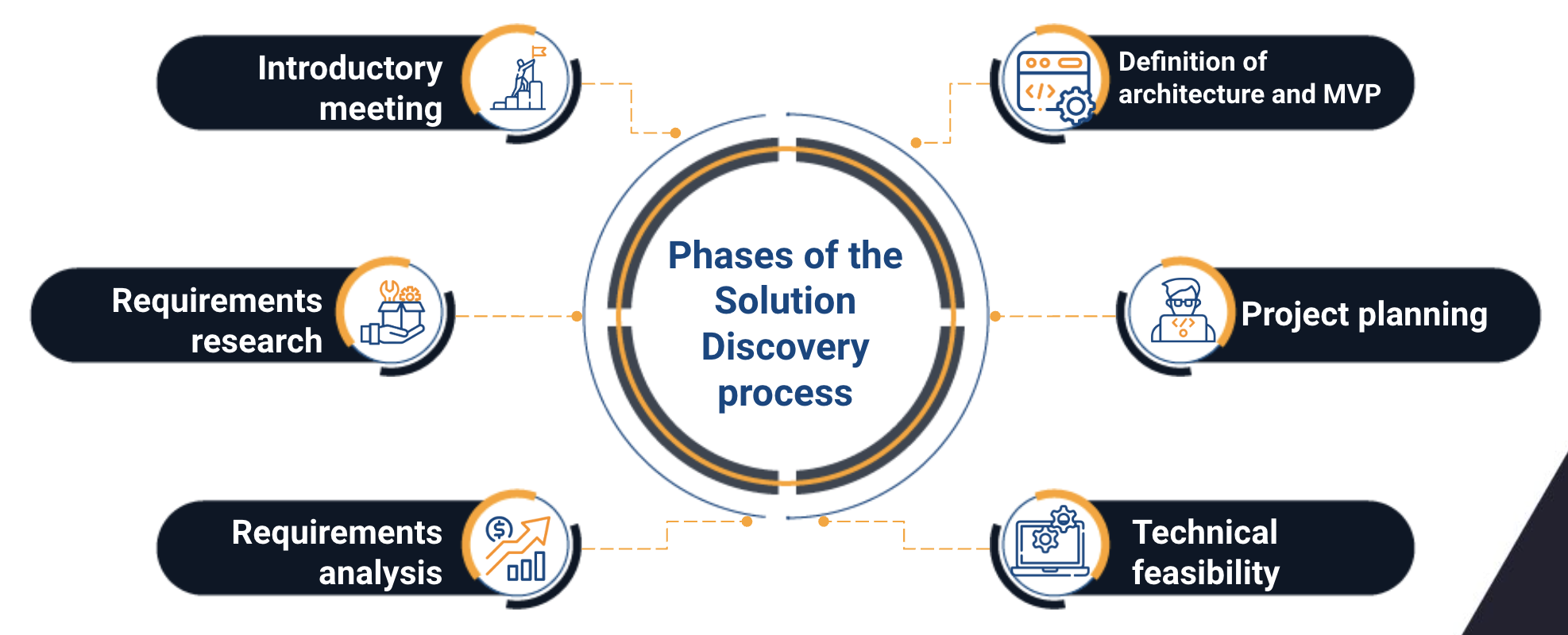
What is the objective of the solution discovery process?
November 05, 2024
Table of contents
Quick Access

In software development, the solution discovery process has become essential to ensure that each project is aligned with business objectives and end-user needs. In this guide, we will explain what solution discovery is, its key objectives, and how it helps companies minimize risks and maximize ROI.
What is Solution Discovery?
Solution discovery is an early phase in the software development process that aims to identify specific project requirements and align the expectations of all stakeholders. This process involves a series of collaborative activities, such as workshops, interviews, and needs analysis, to create a clear, shared vision of the product to be developed.
Rather than jumping straight into development, solution discovery helps ensure that the team has a deep understanding of the goals, challenges, and possible solutions before investing significant resources.
Main Objective of Solution Discovery
The main objective of the solution discovery process is to minimize risks and optimize the results of the software project. To do this, it focuses on key aspects such as:
- Definition of objectives and expected results: Align the vision of the project with the strategic objectives of the company.
- Identification of user needs: Thoroughly understand who the end users will be and what their needs are.
- Technical feasibility analysis: Evaluate whether the desired ideas and functionalities are feasible from a technical and economic point of view.
- Identification of potential risks: Anticipate problems that may arise in development and plan appropriate mitigations.

Benefits of Solution Discovery
1. Alignment of expectations
One of the most important benefits of solution discovery is that it aligns the expectations of everyone involved in the project, from management and business owners to the technical team. In this process, each stakeholder contributes their vision and priorities, and ensures that everyone is on the same page before development begins. This reduces the chance of mismatches in expectations and ensures that the project stays focused on objectives.
2. Identification of problems and opportunities early on
Through solution discovery, companies can identify potential problems and opportunities for improvement at an early stage. This allows adjustments to be made before the team starts writing code, saving time and resources. In addition, this approach helps identify potential competitive advantages by understanding how the software can offer unique value to users.
3. Reduced costs and risks
Lack of clarity in requirements or project vision can lead to unnecessary expenses and development delays. With solution discovery, teams gain a detailed understanding of essential features and functionality, enabling more accurate budgeting and planning. Additionally, by identifying and assessing risks, companies can implement strategies to minimize issues that may arise during development.
4. Validating technical feasibility
Solution discovery allows the technical feasibility of the project to be assessed before development begins. By analyzing technical resources and potential constraints, companies can determine whether it is possible to create the desired product within the available specifications and budget.
This analysis is especially important for companies that wish to innovate with new technologies, as the solution discovery process helps define the scope of what can be achieved.
5. Prioritizing features
During solution discovery, the team and stakeholders can prioritize software features according to their impact and cost. This ensures that resources are strategically allocated to the features that provide the most value to the business and users. Prioritization also helps structure a clear roadmap for the project, with incremental value deliveries that can be evaluated and adjusted as needed.
Phases of the Solution Discovery Process
The solution discovery process is often divided into several key phases, each of which brings specific value to the project:
1. Introduction Meeting
This initial phase involves a meeting between the development team and business stakeholders to understand the overall context of the project. Initial ideas are presented, objectives are identified, and a preliminary vision of the product is established.
2. Requirements Research and Analysis
In this phase, the analysis of the functional and non-functional requirements of the project is carried out in depth. Interviews with end users and stakeholders, competitive analysis, and market research are conducted to gather all relevant information. This ensures that the needs and desires of users are taken into account from the start.
3. Technical Feasibility Assessment
Here, technical experts assess the feasibility of the project based on the requirements. Available technologies, infrastructure constraints, and other factors that may influence the development of the product are reviewed.
4. Defining the architecture and MVP (Minimum Viable Product)
With the information gathered, the team defines the system architecture and the initial features of the Minimum Viable Product (MVP). The MVP represents a functional version of the product with the minimum functionalities needed to solve the main problem. This allows the idea to be tested in the market and to receive early feedback before investing in more complex developments.
5. Project planning
Finally, a detailed project plan is created that includes the tasks, budget, milestones, and development schedule. This plan guides the team in the execution phase and ensures that all activities are aligned with the objectives established during solution discovery.

When is the best time to implement Solution Discovery?
Solution discovery is especially useful in large or complex projects, or when the team is working on an innovative or poorly defined concept. It is also ideal in projects where multiple stakeholders are involved or when you have a general idea of the product, but you don't know how to execute it technically.
Implementing solution discovery at the beginning of any software project ensures that the team has a complete understanding of the challenges and opportunities, which increases the likelihood of success.
Solution discovery is an essential process that allows companies to align expectations, minimize risks, and optimize resources in software development projects. This process not only ensures that the development team and stakeholders are on the same page from the beginning, but also allows problems to be anticipated and resolved early, optimizing the use of resources.
By investing time in solution discovery, companies can develop solutions that truly provide value to users and align with their business objectives.
We recommend you this video
Related Blogs
.jpg)
Costs of developing a web portal

Tools for developing a web portal
.jpg)
Steps to develop a real estate web portal

Aspects to consider for the development of an insurance web portal
.jpg)
Steps to develop a web portal

